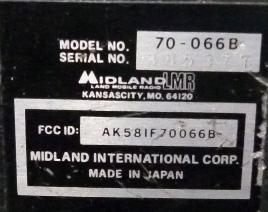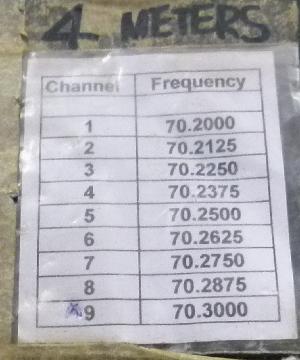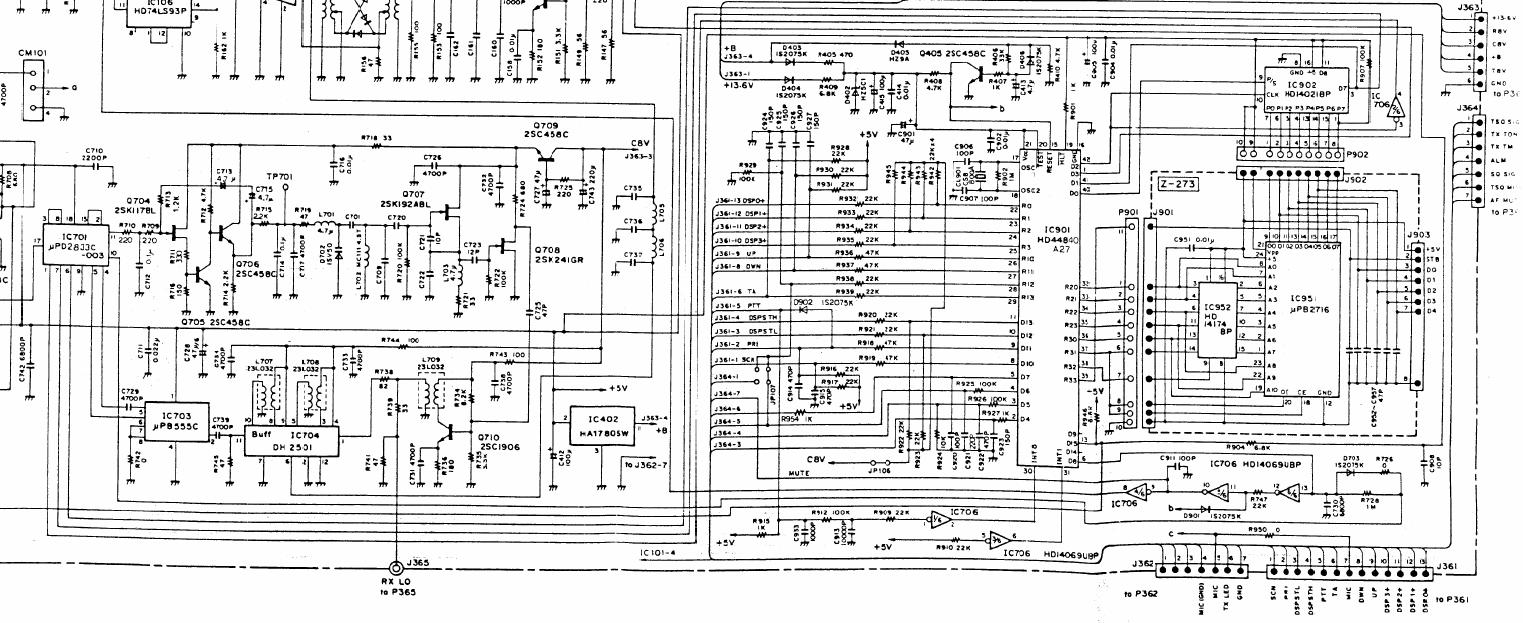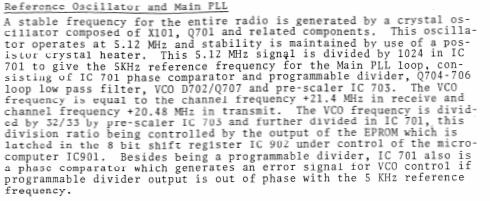Midland 70-066B

|
The Midland 70 series mobile transceivers were made from the early eighties
to the mid nineties. There are three types, Syntech I (ST-1), XTR and
Syntech II (ST-2). As far as I know they were made by Mitsubishi.
The 70-066B is a
Syntech I,
75 - 88 MHz, 40 Watt, 80 channel model. Mine is programmed for the
simplex FM channels.
Channel programming is via a 2716 EPROM, which needs to be removed and re-programmed to
change things. Of course one needs
a special programmer
(which I don't have).

|

|
Reverse Engineering the EPROM
Note: About halfway through this process
I learned that the
Midland LMR Yahoo group has an
executable that creates the EPROM image for you. You still have to desolder the EPROM to
program it in a conventional programmer, but that's trivial.
However, reverse engineering is still fun.


|
The PLL is IC701, labelled what looks like
uPD 2833C-003
in the schematic but MPD3805C-003
in the parts list. Programming is via pins 1, 7 and 6 (data, clock, load) which go all the
way across the page to the HD44840 microprocessor and the
4021 shift register.
The PLL works in conjunction with a dual-modulus prescaler, in this case a
uPB555C
which is
almost,
but not quite entirely unlike an LM555. Had me fooled for a while. Anyway, the uPB555C divides by
32/33 since M1 and M2 (pins 8 and 7) are connected to ground.
If you're not familiar with dual-modulus PLL, maybe the last page of the
MC145158 datasheet is a good place
to start.
NT = NP+A, where P = 32, A is the 7 bits going to the swallow counter and N
is the 10 bits going to the main counter.
The 5.12 MHz clock is divided by 1024 to provide a 5 kHz reference. At a operating frequency
of say 70.2 MHz, the receive VCO frequency will be +21.4 = 91.6 MHz and the transmit VCO
frequency will be +20.48 = 90.68 MHz. This gives NT = 18320 and 18132 respectively.
|
18320 / 32 = 572.5 = %10 0011 1100 (10 bits)
18320 - (572 * 32) = 16 = %001 0000 (7 bits)
Alternatively
18320 = %100 0111 1001 0000 (15 bits) and then you have to extend the 5 low-end bits to seven
(this is what the datasheet is trying to tell you)
100 0111 100 xx 1 0000 (17 bits)
1000 1111 0000 1000 0 = 0x8F08 0
And since the datasheet says that the MSB of the 17 bit data word is shifted in first, and
since the MSB of the EPROM is shifted out first, I'd expect 8F 08 to occur somewhere in
the EPROM binary but it doesn't. The non-shifted
1 0001 1110 0001 0000 = 0x11E10
however does. Looks as if the processor starts shifting from byte zero for the channel,
reading the bit in via D1, and the first 15 bits get clocked through the PLL shift register
and fall out the other side, after 32 clocks the last 17 bits are in the PLL shift register
and then it gets loaded into the data register.
All the calculating was wearing me down, so I
wrote some code.
# freq Rx f Tx f divr divt Rx Data Tx Data
1 70200 91600 90680 18320 18136 11E10 11B18
2 70215 91615 90695 18323 18139 11E13 11B1B
3 70225 91625 90705 18325 18141 11E15 11B1D
4 70240 91640 90720 18328 18144 11E18 11B80
5 70250 91650 90730 18330 18146 11E1A 11B82
6 70265 91665 90745 18333 18149 11E1D 11B85
7 70275 91675 90755 18335 18151 11E1F 11B87
8 70290 91690 90770 18338 18154 11E82 11B8A
9 70300 91700 90780 18340 18156 11E84 11B8C
(I rounded up the 12.5 kHz channels after the fact)
These values all appear in my binary so I must be on to something.
00000000 FF FF FF FF FF 01 1E 10-FF 01 1E 13 FF 01 1E 15 ................ Receive channels
00000010 FF 41 1E 18 FF 01 1E 1A-FF 41 1E 1D FF 01 1E 1F .A.......A......
00000020 FF 41 1E 82 FF 41 1E 84-FF FF FF FF FF FF FF FF .A...A..........
00000200 FF FF FF FF 00 01 1E 10-00 01 1E 13 00 01 1E 15 ................ Receive channels
00000210 00 41 1E 18 00 01 1E 1A-00 41 1E 1D 00 01 1E 1F .A.......A...... 00 instead of FF
00000220 00 41 1E 82 00 41 1E 84-FF FF FF FF FF FF FF FF .A...A.......... high byte
000003F0 32 FF FF FF FF FF FF FF-FF FF FF FF FF FF FF FF 2...............
00000400 00 FF FF FF 72 41 1B 18-09 41 1B 1B 56 41 1B 1D ....rA...A..VA.. Transmit channels
00000410 41 01 1B 80 FF 41 1B 82-FF 01 1B 85 FF 41 1B 87 A....A.......A.. Some high bits set
00000420 FF 01 1B 8A FF 01 1B 8C-FF FF FF FF FF FF FF FF ................ "41"
00000600 FF FF FF FF 00 41 1B 18-00 41 1B 1B 00 41 1B 1D .....A...A...A.. Transmit channels
00000610 00 01 1B 80 00 41 1B 82-00 01 1B 85 00 41 1B 87 .....A.......A.. Some high bits set
00000620 00 01 1B 8A 00 01 1B 8C-FF FF FF FF FF FF FF FF ................
But as I said, this is just for interest, get the MPR70 executable from the
Midland LMR Yahoo group
(run it in DOSBox).
12.5 kHz / 2.5 kHz channel spacing
In South Africa we started off with 25 kHz channel spacing with the option of moving to
12.5 kHz channel spacing when the bands get congested. The 70 MHz band is shared with other
users who tend to use 25 kHz spacing, which means that we can use the "in-between"
channels without interfering with one another. This is evidenced by the channels programmed
into my radio, except that the radio physically only offers 5 kHz spacing so the channels
of interest are all off by 2.5 kHz.
Converting the 70-066 to "splinter" frequencies
Midland calls them "splinter" frequencies. It doesn't really matter whether the
channel spacing is 12.5 kHz or 2.5 kHz, either will give me what I need.

The Service Manual is wrong.
The manual for the 70-1000 programmer corrects this. 80, 8B and 8D
are high side injection, 8A, 8C and 8E are low side injection.
I fired up the software and created an EPROM image with the first channel at 70.200 MHz receive and
transmit. Did this for all six codes, and dumped the EPROM images.
code Rx bin Tx Bin Rx div Tx div Ref Rx VCO Tx mix Rx injection Tx
80 011E10 011B18 18320 18136 5 91.600 90.680 : 91.600 - 70.200 = 21.400 (high side inj) 90.680 - 20.48 = 70.200
8A 009880 009B18 9760 9944 5 48.800 49.720 : 70.200 - 48.800 = 21.400 (low side inj) 49.720 + 20.48 = 70.200
8B 007280 006F90 7328 7152 12.5 91.600 89.400 : Same as 80 89.400 - 19.20 = 70.200
8C 003D00 003F90 3904 4080 12.5 48.800 51.000 : Same as 8A 51.000 + 19.20 = 70.200
8D 011E20 011B30 36640 36272 2.5 91.600 90.680 : Same as 80, uses 64/65 swallow counter 90.680 - 20.48 = 70.200
8E 013100 013690 19520 19888 2.5 48.800 49.720 : Same as 8A 49.720 + 20.48 = 70.200
Note that the 8D Rx value is 0x11E20 = %0001000111100 01 00000. The "filler" bits are not zero, which
tells me the swallow counter value is not five bits but six, i.e. the dual modulus prescaler is a 64/65 counter
and not a 32/33 counter. Some googling tells me the uPB571C (pin compatible to the uPB555C) will do the job.
Since my goal is to get the splinter frequencies, I can ignore the low side injection option, leaving me with the choice
of 8B (which implies changing the transmit VCO frequency to 19.2 MHz) and 8D (which uses a different swallow counter).
Since the uPB571C is
easily found on eBay, 8D would be my preferred route.
8D is also easier because with the transmit VCO not changing, only one reference frequency needs to change.
80/8A: 5.12 MHz / 1024 = 5 kHz PLL reference, 5.12 MHz / 4 = 1.28 MHz = [Tx mix - Tx VCO | Tx VCO - Tx mix] / 16
8B/8C: ? = 12.5 kHz PLL reference, ? = 1.2 MHz = [Tx mix - Tx VCO | Tx VCO - Tx mix] / 16
8D/8E: 5.12 MHz / 2048 = 2.5 kHz PLL reference, 5.12 MHz / 4 = 1.28 MHz = [Tx mix - Tx VCO | Tx VCO - Tx mix] / 16
The 5 kHz reference needs to be divided by two to give a 2.5 kHz reference for the PLL. It looks as if the spare flip-flop in
IC702 (74LS93) might do the job, but I am worried about the control line from the processor D15 to IC702 pins 2 and 3. The
divider might be disabled during receive.
Update: I got hold of the 70-2138 (2.5 kHz steps, low side injection) and 70-2139 (2.5 kHz steps, high side injection)
instructions. The hardware required consists of 150mm 28AWG wire (70-2138) and 150mm jumper wire + a uPB571C prescaler (70-2139).
This confirms that my analysis is correct. Go me. The instructions also call for grounding ping 2 and 3 of IC701 and cutting the
trace to the micro, so my guess that the divider is only enabled during transmit is correct, but obviously running it all the
time doesn't make a difference.
70-2138 Page 1
70-2138 Page 2
70-2139 Page 1
70-2139 Page 2
70-2139 Page 3
Of course, for true 12.5 kHz channel spacing I'd also need to install 70-2135, which consists of a replacement 21.4 MHz crystal
filter and two replacement 455 kHz ceramic filters. But I'm not really worried about that, as I said we use the "12.5 kHz"
channels mostly and there's no real traffic on the "25 kHz" channels.
Still no idea how modes 8B/8C work.





